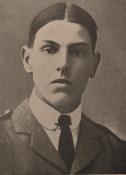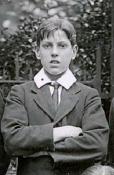
|
The King's School Canterbury |
Roll of Honour |
| 2nd Lieutenant Cyril Francis HODGSON | |
|
2nd Battalion 124th Duchess of Connaught's Own Baluchistan Infantry Date of birth: 10th September 1897 Date of death: 11th January 1917 Killed in action aged 19 Buried at Amara War Cemetery Plot XVIII Row K Grave 2 |

|
| He was born at Cheriton Rectory, Shornecliff in Kent on the 10th of September 1897 the fifth son of the Reverend Francis Douglas Hodgson MA, Vicar of St Peter and St Paul's Church, Worth, and Margaret (nee Hassell) Hodgson of Worth Cottage, Broadstairs in Kent. He was christened at Cheriton on the 5th of November 1897. He was educated at Sunningdale School in Berkshire and at the King's School Canterbury from January 1912 to March 1915, where he gained an entrance scholarship and played for the Cricket XI in 1914. He earned his cricket colours in July 1914 and his sports colours in March 1915. The Cantuarian wrote the following of his 1914 cricket season:- "A somewhat uncertain but dashing bat, has made runs when badly needed. A very fair field." On leaving school he decided to join the Indian Army and attended the Royal Military College in Quetta in 1915. He was commissioned as a 2nd Lieutenant on the Unattached List of the Indian Army on the 15th of November 1915 and was attached to the 2nd Battalion 124th Duchess of Connaught's Own Baluchistan Infantry, part of the 8th Jullundor Brigade, 3rd Lahore Division the following day. During his training he wrote a letter which was reproduced in the Cantuarian:- "... tomorrow's regimental orders have just come in and I see we are parading at 1.45 for swearing in recruits. This ceremony is performed when a man has finished his recruit's training and is considered fit to serve in the ranks as a Sepoy. It is very impressive and differs for the Sikhs and the rest, who are all Mussulmans. The Sikh swears allegiance to the King Emperor on his holy book, the Granth, and the others produce each a multicoloured handkerchief and place it on a tray one by one, dipping their foreheads into the pile thus made; then they give their respective war cries according to their religion, their comrades in the ranks, who are formed round on three sides of a square, joining in. It is very different from the deep throated British cheer, being a very shrill and decidedly blood curdling yell. The Sikhs say "Victory to the arms of the Sikhs"; I don't know what the others yell---probably something of the same sort. Then the colour party marches into the centre to the sound of the pipes and drums and the bearers face each other, crossing the King's Colour with the Regimental Colour at the top of the staff, thus forming an arch under which the recruits march in single file, salaaming and touching the flags with uplifted hands as they pass under..." He landed in Mesopotamia in January 1916 and was promoted to Lieutenant on the 15th of November 1916. He was killed while leading a bombing attack on enemy trenches during the advance to the Haj and the capture of the Khudaira Bend (December 1916 to the 19th of January 1917). He is commemorated on the war memorial at Worth, on a plaque in St Nicholas' Church, Worth and at St Michael's Church, Throwley, Faversham in Kent. |
|
 | |
| School House |
Back